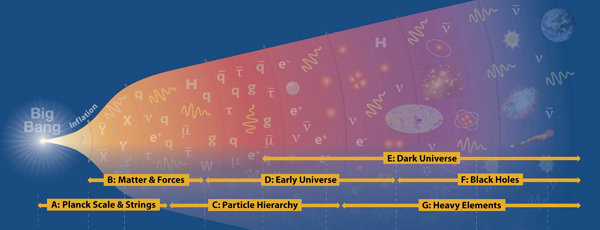Research at the Universe Cluster
The research objective at the Cluster is the Universe: how it formed, how it has developed to this day and how it will develop in the future. From a scientific perspective, this overriding question is divided up into numerous individual themes, which are categorized into seven research areas within the Excellence Cluster Universe.
A: How do matter and forces behave at the highest energies?
B: What are the symmetries in the early Universe?
C: What is the origin of particle flavour and mass?
D: What are the phase transitions in the early Universe?
E: What is the nature of dark matter and cosmic acceleration?
F: What processes drive the building of the visible structures in the Universe?
G: What is the cosmic history of element formation?
The questions from A to G reflect the developmental steps in the Universe. When one considers the time scale involved, it is obvious that the first three minutes after the ‘‘Big Bang’’ are given particular significance. Four research areas deal with those processes that took place during this extremely short period of time. Within those three minutes all the building blocks of the (now 13.8 billion-year-old) Universe were created: space, time and matter.
To this day, there are no confirmed findings as to what happended during those first fractional seconds after the ‘‘Big Bang’’ (A). Yet, cosmologists have a good idea of the evolution of the Universe. At first, particles and forces evolved. Later, the first chemical elements hydrogen, helium and lithium (B, C, D) were formed. This mixture of matter gave rise to the stars, black holes and to galaxies (E, F). Stars and stellar explosions are the chemical factories of the cosmos: They provide for a constant re-supply of elements such as oxygen, carbon, silicon and iron right up to the heavy uranium atoms (G).





